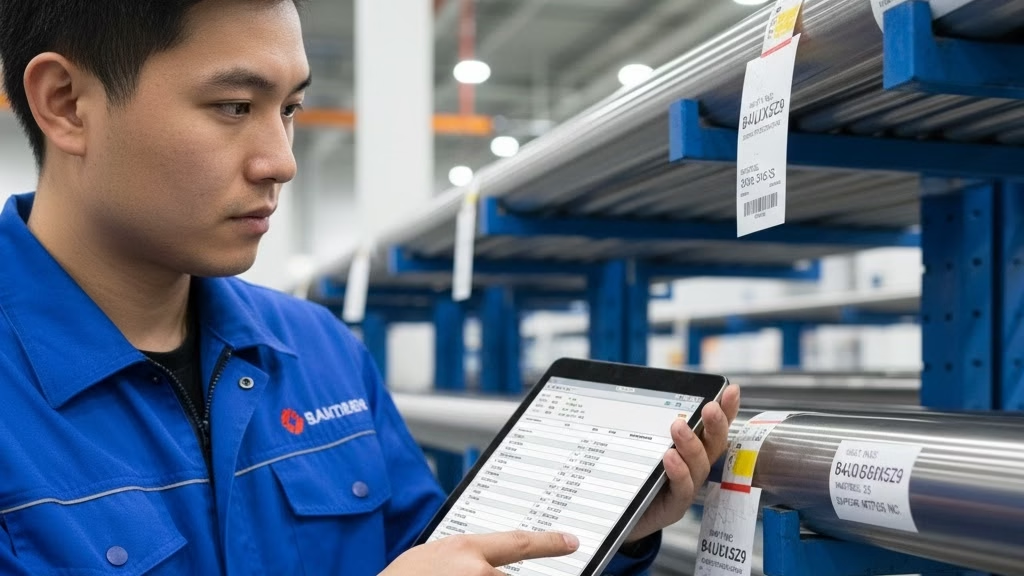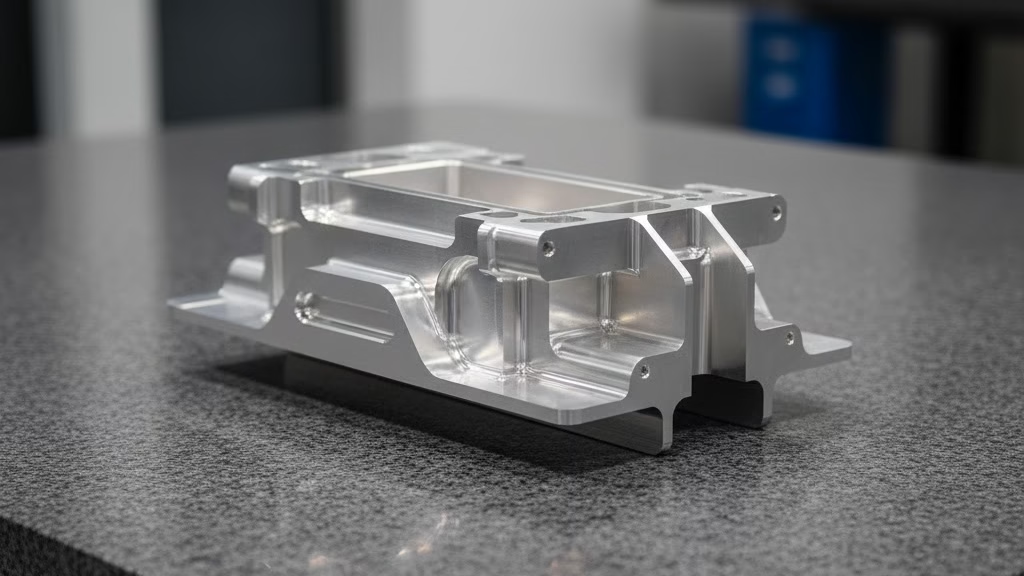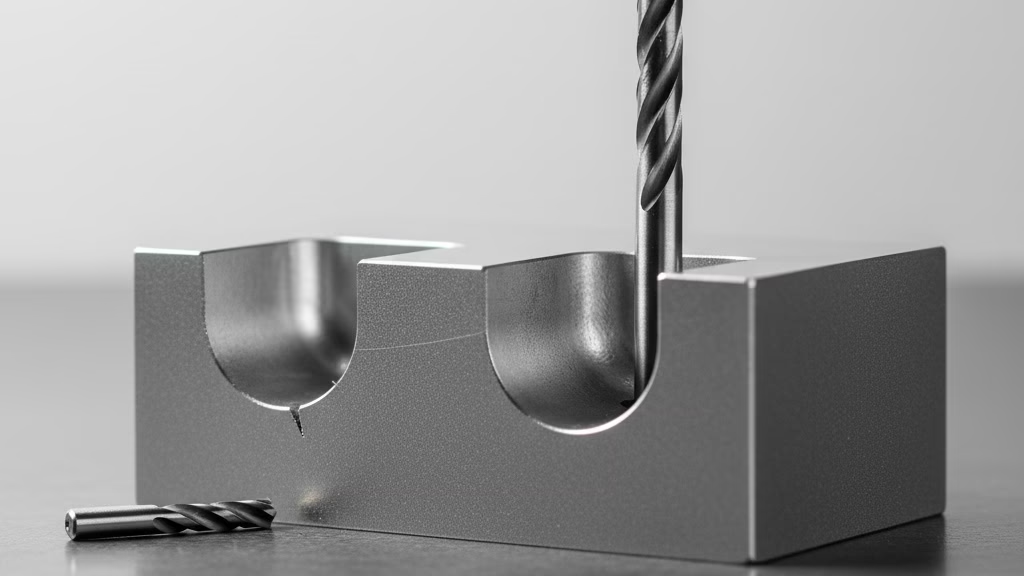Are you tired of “ghost defects” and batch quality variation? This guide provides a proven framework for diagnosing inconsistent quality. Learn how to prove the problem is material consistency and implement the right raw material QC steps to stop it for good.
Quality varies within the same batch due to inconsistent material consistency. This variation is often caused by poor raw material QC, where suppliers mix materials from different metallurgical “heat numbers.” These different batches, while technically “in spec,” have slight variations in composition or hardness, leading to unpredictable results, defects, and production downtime.
But diagnosing the problem is only the first step. Read on to get our 4-step supplier QC checklist and learn the “1-10-100 Rule” to finally get your procurement team on board.
The Diagnostic Toolkit: Isolating the “Ghost Defect”

When a “ghost defect” appears, the first reaction in the plant is often to find the nearest person to blame. Before you get pulled into a pointless argument, use this simple triage checklist to scientifically isolate the variable. This is your first line of defense.
The “Process vs. Material” Checklist: Your First 5 Minutes of Triage
Your goal is to quickly determine if the problem is random or follows a pattern. Ask these questions immediately:
Process Checks (Is it us?)
- Machine: Did the machine parameters change? Is it holding tolerance?
- Tooling: Is the cutting tool near the end of its life? Has a new tool been inserted?
- Operator: Is this a specific shift? Is the operator new or following the standard work instruction?
If the answers to these are all “no,” the suspicion immediately shifts.
Material Checks (Is it them?)
- Timing: Did the defects start immediately after a new coil, bar, or pallet of material was loaded?
- Traceability: Do all the failed parts trace back to a single heat number or supplier lot number?
- Pattern: Are the defects happening at the beginning or end of a specific material batch (e.g., the first or last few feet of a steel coil)?
This checklist isn’t just for you; it’s a communication tool. When you can walk into the production meeting and say, “We’ve confirmed all process variables are stable, but 100% of the defects occurred after we loaded material from Heat Number #XYZ,” the conversation changes.
You are no longer defending a guess; you are presenting an evidence-based diagnosis.
Why “Acceptable” (On Paper) Is Not “Consistent” (In Production)
Here’s where most QC managers get stuck. You’ve isolated the material, but the supplier sends you a Mill Test Certificate (MTC) showing the material is perfectly “in spec.”
This is the “Dual MTC Trap,” and we’ve lived it.
We had a medical device client with a successful product. On their second mass-production order, they called us, furious. Their QC was seeing “random” breakages on their assembly line. Our own out-of-factory (OQC) reports showed every part was 100% compliant.
We immediately traced our internal lots. Here’s what we found:
To “optimize costs” for the second run, our procurement team had sourced the same-spec material from a new, cheaper supplier. Both suppliers provided “qualified” MTCs.
But when we laid the two MTCs side-by-side, the problem was obvious.
- Supplier A (Expensive): The key alloy element (molybdenum) was at the high end of the tolerance range.
- Supplier B (Cheaper): The same element was at the low end of the tolerance.
Both were technically “acceptable” and passed inspection. But their actual physical properties—specifically toughness—were dramatically different. The “random” failures weren’t random at all; they were 100% correlated with the parts made from Supplier B’s material.
This taught us a critical lesson: Your enemy is not “non-compliant” material; your enemy is “inconsistent” material. Your job is to fight for consistency, because that is the only way to ensure a stable production process.
How to Win the Argument with Proof

You’ve done your diagnosis, and you’re 99% sure the material is the culprit. Now you have to prove it. This is where you get stuck in the “he said, she said” loop with your supplier and your procurement team.
To win this argument, you need hard evidence. That evidence lives in the paperwork—if you know how to read it.
MTC vs. CoC: Decoding the PaperTrail
When you flag a material issue, your supplier will email you a document, usually a Certificate of Conformance (CoC). This document is often meaningless.
- A Certificate of Conformance (CoC) is just a declaration. It’s your supplier printing a piece of paper that says, “We promise the parts we sent you are good.” It’s a “trust me” note.
- A Mill Test Certificate (MTC) is a birth certificate. It is a quality and test report issued by the original mill that smelted the metal. It shows the exact chemical composition and physical properties of that specific batch.
We once had a new customer complain that his existing supplier’s quality was erratic. He showed us the supplier’s CoC. It was clean, simple, and utterly useless. It was missing the one piece of information that mattered: the original Heat Number.
That supplier was almost certainly buying “mixed stock” or “remnants” from various distributors, processing them, and then lumping them all under his own self-generated CoC. He couldn’t provide the original MTC because he didn’t even know where most of the material came from.
Your action: Demand the original Mill Test Certificate for every batch. If your supplier gets defensive, delays, or sends you a generic CoC, you’ve found your red flag.
Why You MUST Track the “Heat Number”
Stop tracking “shipping batches” or “PO numbers” as your primary quality lot. These are just accounting numbers. The only number that matters for traceability is the Heat Number (for metals) or Lot Number (for plastics).
This number is assigned by the mill to a single, specific “pudding” of material. Everything from that “pudding” will have the same DNA.
Why does this matter? Your supplier may send you 500 parts on Monday and 500 on Tuesday as part of the “same batch.” But if Monday’s parts were made from Heat #AAA111 and Tuesday’s from Heat #BBB222, they are not the same batch. They are two different products, and they can (and often do) behave differently in production.
When you investigate a quality failure, this is your legal and technical foundation. Dr. Kaoru Ishikawa, a pioneer in quality control, developed the “Fishbone Diagram” (or Cause-and-Effect Diagram) to find the root cause of a problem. He identified “Materials” as one of the primary “bones”—a formal, foundational category for investigation.
Your job is to connect the “Effect” (the defect) to the “Cause” (the material). The Heat Number is the thread that ties them together. When you can show that all failures come from Heat #BBB222, you are no longer presenting a theory. You are presenting an objective fact.
What Your Supplier Isn’t Telling You
You’ve done your diagnostics and checked the paperwork. But the problem still happens. Why? Because the biggest risks are often hidden one or two steps up the supply chain. This is the black hole where traceability goes to die.
| Problem Area | Root Cause (What’s Happening) | QC Solution |
|---|---|---|
| Supplier Sourcing | Your supplier mixed materials from different mills (Heat #AAA and Heat #BBB) into your “single” order. | Mandate “Heat Number” traceability on all MTCs and POs. |
| Documentation | Your supplier only provides a CoC (a “promise”) instead of an MTC (a “birth certificate”). | Never accept a CoC without a corresponding MTC. |
| Internal Process | Your own warehouse mixed old “remnant” material with a new, certified batch on the same work order. | Implement strict inventory lot control; enforce “First & Last Piece” protocol. |
| Physical Variation | A single bar of material has inconsistent hardness from one end to the other due to poor heat treatment. | Use PMI guns and hardness testers at incoming inspection (IQC). |
Who Really Made Your Material?
Here’s a hard truth: you probably don’t know who made your material.
You have a contract with your supplier, let’s call them “Supplier A” (your CNC machine shop). But Supplier A doesn’t smelt steel; they buy it from “Supplier B” (a metal distributor).
Here’s where it gets dangerous:
- Cost Optimization: To save a few cents, Supplier A might buy from Supplier B in July and from Supplier C in August. They won’t tell you this, because the material “meets the spec.” But as you’ve learned, “in spec” does not mean “consistent.”
- The Distributor’s Mix: The problem gets worse. Supplier B (the distributor) needs to fill your Supplier A’s order for 1,000 lbs of 316 Stainless. They have 700 lbs from Mill D (Heat #DDD444) and 300 lbs from Mill E (Heat #EEE555). They “bundle” them together, often under one generic lot number, and send them to your supplier.
The result? The “single batch” of parts sitting on your dock was knowingly (or unknowingly) made from two completely different materials. Your supplier isn’t just sending you parts; they are sending you a mystery box.
How “Inventory Contamination” Creates Random Defects
Sometimes, the supplier is clean, the paperwork is perfect, but the defects are still there. In these cases, the problem might be coming from inside your own building.
Picture this:
A work order for 1,000 parts is released to the floor. The new, certified material (Heat #AAA111) is staged. But a well-intentioned warehouse operator sees a small “remnant” of the same-spec material from a previous job (Heat #BBB222) sitting on the shelf. To “save costs” and “be efficient,” he has the machine operator use up that remnant first before starting the new coil.
Nobody documents this. That “remnant” (tail-end) might have been from a different supplier, or it may have had hidden stress issues.
Now, 27 parts from that remnant are mixed into a 1,000-piece batch. When you do your sample inspection, you find three defects. You quarantine the batch and inspect all 1,000 pieces, only to find… just those three. The other 997 are perfect.
This is the “internal contamination” ghost. It drives QC managers insane because the problem is invisible, undocumented, and created by people trying to do the “right thing” (reduce scrap). This isn’t a supplier failure; it’s an internal process failure.
How to Make Management Listen

You’ve found the proof. You know the material is the problem. But when you bring this to procurement or senior management, you’re met with resistance.
Why? Because you’re speaking the language of quality (“hardness,” “composition,” “microstructure”), but they speak the language of finance (“cost,” “profit,” “margin”).
Your greatest frustration is this “internal communication failure.” Your technical complaint about “material inconsistency” sounds like background noise to them. To get them to act, you must become a financial translator. You have to convert your technical defect into a clear, painful dollar amount.
Stop Talking “Hardness,” Start Talking “Downtime Cost”
Your procurement team saved 8% on a cheaper material. You need to show that this 8% savings just cost the company 500%.
Start using the metric that makes executives panic: Cost of Poor Quality (COPQ).
Your argument isn’t, “This material is bad.” Your argument is, “This inconsistent material is destroying our profitability.” Show them the real math:
COPQ = Internal Failure Costs + External Failure Costs
- Internal Failure Costs: “This bad material lot caused a 3% spike in our scrap rate (a loss of $15,000). It also caused 4 hours of unplanned production downtime on our CNC line. According to Aberdeen Research, the average cost of one hour of downtime is $260,000. That ‘cheap’ material just cost us over $1 million in lost production.”
- External Failure Costs: “And what if it gets to the customer? A single product recall from our automotive client could mean $2 million in penalties, not to mention permanently losing their $10 million/year account.”
When you frame it this way, you’re no longer just the “quality guy”; you are a strategic manager protecting the company’s bottom line.
Proving Why “Cheap” Materials Are Most Expensive
Here is the most powerful tool in your financial translation kit. The “1-10-100 Rule” is a foundational concept in quality management, and it should be your Bible when speaking to finance.
- It costs $1 to prevent a defect (e.g., proper incoming QC on raw material).
- It costs $10 to correct a defect found internally (e.g., scrapping or reworking a part on your line).
- It costs $100 (or more) to fix a defect after it reaches the customer (e.g., recalls, warranty claims, lawsuits, and brand damage).
This rule gives you the ultimate rebuttal to the “price-only” procurement strategy. You can walk into the CFO’s office and say, “The purchasing team is trying to save 50 cents on this material. But by skipping proper incoming validation, they are exposing us to a $100 external failure cost.
Every dollar we spend on our incoming ‘quality firewall’ saves this company $99 in future failure costs.”
“End the Practice of Awarding Business on Price Tag”
If you still meet resistance, bring in the authority of a legend. Dr. W. Edwards Deming, the father of the modern quality revolution, built his entire philosophy on this.
His “Point 4” of his famous 14 Points for Management states: “End the practice of awarding business on the basis of price tag. Instead, minimize total cost. Move toward a single supplier for any one item, on a long-term relationship of loyalty and trust.”
This isn’t your opinion; this is the foundational principle of world-class manufacturing. You can tell your team that a procurement strategy focused only on the initial price is, by definition, a strategy that creates inconsistent quality, increases total cost, and guarantees that you will have this exact same “ghost defect” problem again and again.
Tired of Blaming, Ready for a Partner?
Inconsistent materials create scrap, waste time, and destroy profits. Zenithin’s 100% transparent material traceability and IQC process act as your quality firewall, ensuring every part we deliver is predictable and reliable.
The “No Surprises” Solution: A Bulletproof 4-Step Raw Material SOP
You’ve diagnosed the problem, gathered the financial data, and made your case. Now it’s time to implement a system that prevents this nightmare from ever happening again.
A “no surprises” quality system is built on one principle: control your inputs. You cannot have a consistent output (your parts) if you have an inconsistent input (your material).
This 4-step Standard Operating Procedure (SOP) isn’t just about catching defects; it’s about building a quality firewall.
Step 1: Lock Your Supply Chain (in Writing)
The “Supplier’s Supplier” problem is your single greatest vulnerability. You must close this black hole.
- Your Action: Update your supplier quality agreement immediately. Add a clause that contractually locks in the raw material mill. Your supplier isn’t just committing to a spec; they must commit to a source.
- The “No Change” Clause: This agreement must state that your supplier (Supplier A) cannot change their material provider (Supplier B) or the original mill without your express written consent and a new First Article Inspection (FAI). This eliminates the “cost optimization” loophole that introduces random variability.
Step 2: Trust, but Verify (with Physics)
As we saw in our automotive client story, paperwork can be wrong. The MTC said 316, but the material was 304. A simple human error in a warehouse could have led to a multi-million dollar recall.
Your IQC (Incoming Quality Control) process must be more than just “checking paperwork.”
- Your Action: Do not rely 100% on the MTC. Implement mandatory physical verification for critical materials.
- The Tools: Use a Positive Material Identification (PMI) gun (a handheld XRF spectrometer) to instantly verify alloy composition. At a minimum, use calibrated hardness testers.
- The Rule: If the physical test doesn’t match the paper certificate, the material stops at the door. This 5-minute check is the highest-value insurance policy your company can buy.
Step 3: Implement “Heat Number” Traceability
This is the backbone of your entire solution. If you can’t trace a defect, you can’t solve it.
- Your Action: Mandate that the original Mill Heat Number is the primary lot number for your internal system.
- The Process:
- Receiving: When material arrives, your team records the Heat Number. This number is printed on the internal tag that stays with that material.
- Production: The Heat Number must be recorded on the job traveler or work order.
- Shipping: The Heat Number should be listed on your Certificate of Conformance and shipping label to the customer.
- The Payoff: When a defect is found (either internally or by a customer), you can instantly trace it back to its “birth certificate” (the MTC) and identify every other part made from that same material.
Step 4: The “First & Last Piece” Protocol
This final step closes the loop. It protects you from “within-batch” inconsistency—the problem of a single bar or coil having different properties from one end to the other (often due to uneven heat treatment or internal stress).
- Your Action: Implement a “First & Last Piece” inspection protocol for every new bar or coil of material, not just every new “job.”
- The Process: When a machine operator loads a new bar of material, they must save the first part they make and the last part they make from that specific bar.
- The Check: Your floor QC performs a quick comparison of critical dimensions and properties (like hardness) on these two parts. If they match, the material is internally consistent. If they don’t, you’ve just caught a “within-batch” failure before it created 500 scrap parts.
Conclusion: From Quality Cop to Quality Firewall
Inconsistent quality in the same batch isn’t a random mystery or just “bad luck.” It’s a traceable, solvable problem. It’s an issue of Material Consistency that hides in supplier black holes, confusing paperwork, and broken internal processes.
As a QC Manager, your value isn’t just in finding defects; it’s in preventing them. But you can’t prevent what you can’t control. Gaining control means moving beyond “inspecting” and building a transparent, data-driven firewall that starts long before a part ever hits your production line. It means demanding proof, tracking the right numbers, and translating quality data into financial impact.
Are you tired of the “blame game”?
At Zenithin, we don’t just sell parts; we provide a 100% transparent material traceability system. We believe you have a right to know exactly what’s in your product, which is why we proactively supply full MTC documentation, Heat Number traceability, and our own IQC physical test reports with every critical order.
We aren’t just another vendor. We are your quality firewall.
Ready to Enforce Real Material Consistency?
You’ve diagnosed the problem. Now let us be the solution. Partner with a supplier who provides 100% traceability and physical verification on all raw materials.
References & Notes
[1] The “1-10-100 Rule”: This foundational quality principle was popularized by quality gurus like George E. P. Box and is widely cited in quality management literature. It illustrates the exponential cost increase of fixing defects at later stages of production.
[2] Cost of Poor Quality (COPQ): A core concept in Six Sigma and Total Quality Management, COPQ is the sum of all costs incurred because a product or service was not 100% perfect. This includes internal failure costs (scrap, rework) and external failure costs (warranty, recalls).
[3] Dr. W. Edwards Deming’s 14 Points: From his book *Out of the Crisis* (1986). Point 4, “End the practice of awarding business on the basis of price tag,” is a cornerstone of modern supplier quality management, advocating for a focus on minimizing total cost, not just initial price.




